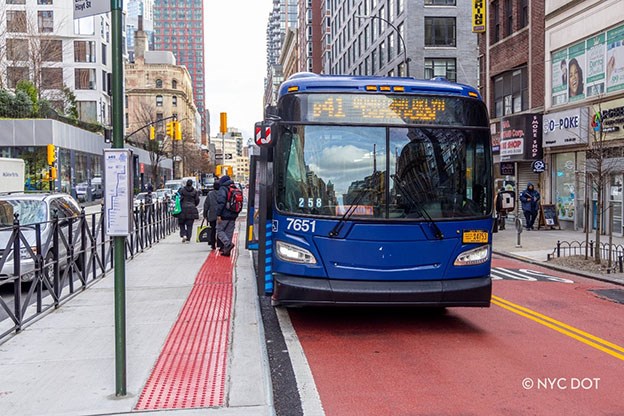The NYC Department of Transportation (DOT) is studying various options for speeding buses on Flatbush Ave.
The mayor has promised to listen to Flatbush Avenue residents regarding any proposed changes.
Here lies the problem. Nowhere does the DOT or the mayor discuss effects on other traffic which is a far departure of the DOT of the 1960s. Any plan back then was subject to a traffic study to make sure the effects on other traffic would not have disastrous implications. No more. Today it is just assumed that buses are too slow and bus lanes are warranted on any street with more than one lane in each direction to make them go faster regardless of bus frequencies.
The fallacy is that buses are not that slow when compared to automobiles, which average 9 to 10 mph on city streets. Local Brooklyn buses average 6.3 mph and buses must make more stops than cars, so they naturally must travel slower. The question on Flatbush Avenue is how much faster would buses operate with exclusive bus lanes and when should they be in effect? Would it be worth it to increase average bus speeds to 10 mph, if possible, if that means all other traffic is reduced to traveling at an average speed of 5 mph or slower?
Also, for bus lanes to make sense, bus frequencies should be no greater than every five minutes. Flatbush Avenue qualifies between Livingston Street and Avenue N, where buses operate in peak hours about every three or four minutes. This is especially true for the two blocks between Livingston Street and Atlantic Avenue, where bus speeds average less than 4 mph during peak periods, according to the DOT, provided it does not result in gridlock for other traffic.
That could be a real problem if traffic is backed up between Grand Army Plaza and Atlantic Avenue, as there are few alternatives since all left turns are banned at all times. Also, if three lanes are not returned to the Brooklyn-Queens Expressway after reconstruction is completed, another alternative to Flatbush Avenue is eliminated. On weekends, Vanderbilt Avenue was already removed as an alternative.
Also, the DOT already removed a traffic lane to institute bike lanes between Empire Boulevard and Eastern Parkway. What would be the effect on other traffic if another lane were lost to an exclusive bus lane? What would average traffic speeds be reduced to? That question must be answered prior to making any changes there.
During midday, buses operate about every four minutes, but the MTA is proposing to cut that to every five minutes and every six minutes north of Empire Boulevard under the Brooklyn Bus Network Redesign. One question is if it makes sense to institute exclusive bus lanes and reduce service at the same time? How will bus riders benefit and what will be the effect on other traffic?
It should be noted that the exclusive bus lanes were instituted along the wide portion of Kings Highway although DOT’s own numbers showed buses were averaging 21 mph during peak hours, with a 25 mph speed limit before the bus lanes were instituted, so how could they have sped buses? Meanwhile, average traffic speeds for other vehicles were cut in half.
The bottom line: many factors must be considered, among them the effect on other traffic and the effect on businesses that rely on automobile traffic for their customers. Bus lanes probably would be most effective between Livingston and Atlantic Avenue during peak hours when bus speeds are the slowest at an average less than 4 mph during peak hours, and perhaps during peak hours on some other portions of Flatbush Avenue. Other times, it is doubtful that more would benefit than would be harmed.
It is not as simple as buses are slow and must go faster. There are better ways to speed buses than more exclusive bus lanes such as not permitting double parking by trucks for hours at a time, not permitting deliveries during certain hours, and enacting a state law requiring all vehicles except emergency vehicles to give the right-of-way to buses.
Allan Rosen, a Brooklyn resident, is a former director of MTA NYCT Bus Planning with three decades of experience in transportation and a Master's Degree in Urban Planning. You can find him on X: @BrooklynBus.




